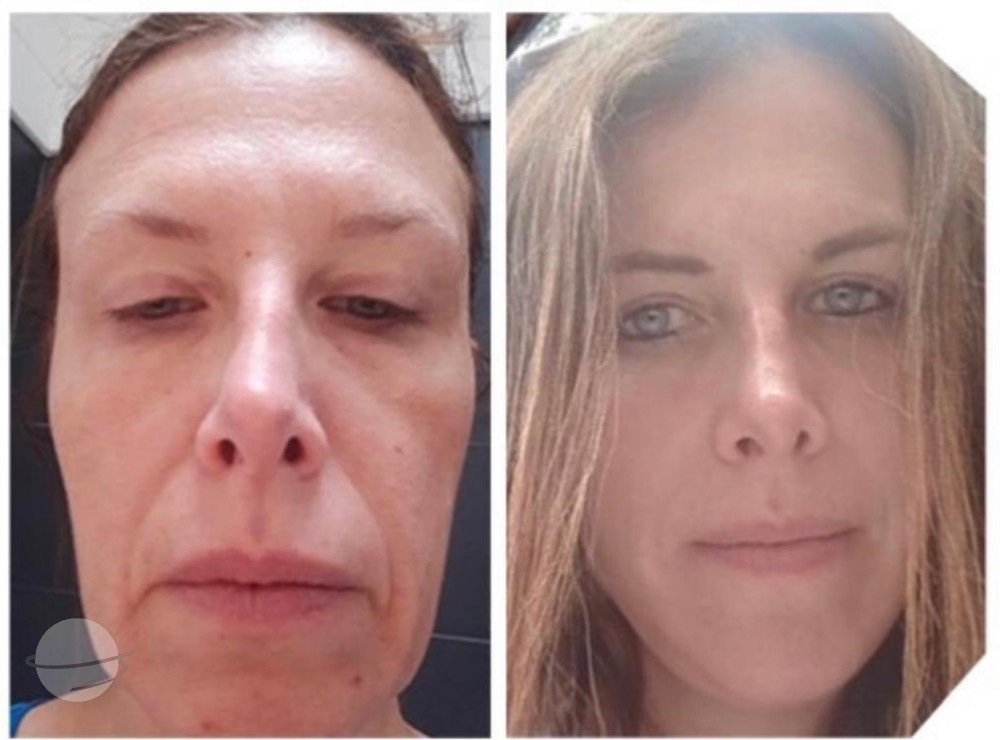
Different Types of Facelifts, Definitions, and Objectives
If our face serves as a reflection of our emotions and personality, it also bears the marks of time. Facelift surgery significantly reduces wrinkles and, in general, all visible signs of skin and neck aging. It provides radiance and rejuvenation without altering facial expressions.
Face Lift details
Face Lift
Prices
About
Definition and Objectives

Facelift can be done as soon as signs of aging appear, typically from the age of 40 or 45 onwards. This procedure can be combined with other facial plastic surgery procedures, such as eyelid surgery (blepharoplasty), correction of forehead sagging and wrinkles (endoscopic forehead lift). It can also be complemented by medico-surgical therapies (laser abrasion, dermabrasion, peeling, medical treatment of wrinkles or folds, injections of botulinum toxin).
Facelift surgery is divided into several different operations, each with specific indications:
- Cervico-facial lift
- Forehead lift
- Mini facelift
- Temporal lift
Cervico-facial lift
The cervico-facial lift works on the face and neck. It's a complete lift.
Medio-facial lift
The medio-facial lift works on the lower half of the face.
Temporal lift
The temporal lift works on the forehead and eyebrows. It is often associated with the Fox eyes.
Procedure
The procedure takes place in several stages, which we will describe to familiarize you with it and answer your questions. First, the muscles are tightened to correct their sagging, allowing for facial rejuvenation. Subsequently, the skin is draped as needed over the new contours without excessive traction. This dual action achieves a natural result because the skin is not pulled too tight. Moreover, this action provides lasting results and generally straightforward post-operative recovery. These positive results are due to a solid muscle plane and the choice of the method used. Your skin will have fewer marks and suffer less trauma due to limited tension and detachment. Additionally, any localized fat deposits can be treated with liposuction. However, if the face is thin, this aspect can be corrected at the same time by autologous fat injection (liposculpture). Thus, the face and neck are somewhat restructured. To ensure a natural and discreet result, the necessary skin incisions are mostly hidden in the hair, at your temple and neck, and around the ear. Your scar is thus almost entirely concealed. There are several common basic techniques: For the first one, the incision is made around the ear to hide the scar in your hair. From the incisions, a detachment is made under the skin. The extent of the incision depends on each case, particularly the extent of tissue sagging. Subsequently, the muscle plane is precisely and dosed for correction of sagging while preserving the facial expression. In the case of localized fat deposits, liposuction is performed in the same surgical procedure, which can target the neck, chin, jowls, and cheeks. The skin is then naturally redraped, excess skin removed, and sutures made without tension. At the end of the procedure, a dressing is applied around the head.
Optimizing and Maintaining a Facelift
Facelift surgery is associated with long-term aesthetic medicine to maintain the rejuvenating effect of surgery for as long as possible.
Botox injections (botulinum toxin): Botox directly acts on forehead wrinkles and crow's feet, and thus generally on the upper part of the face.
Hyaluronic acid injection: Injection on all other parts of the face to stimulate collagen production and maintain skin elasticity and texture.
Lipo-filling (fat injection): Lipo-filling is used on the same areas as hyaluronic acid, often in combination with HA. Your own fat (taken from your own body, always using autologous fat cells) is used to fill hollowed and marked areas due to skin aging.
Resurfacing dermatology (mesotherapy, peeling, laser...): dermatological treatments targeted to the quality of the skin (thick skin, pigmentation, fine wrinkles, or minor imperfections).
Required Anesthesia:
Facelift surgery can be performed under general anesthesia or in rare cases and for certain types of face lifts, under local anesthesia combined with intravenous sedation. Anesthesia often raises questions among our patients. If you have any concerns or questions about anesthesia, please don't hesitate to contact us. We are here to address all your queries and provide the information you need.
Duration of the Procedure:
Depending on the extent of the improvements needed, the facelift procedure can last from 2 to 3 hours. Typically, a hospital stay of 24 to 48 hours is required.

The results of a facelift become apparent after 2 months.
Results
Starting from 2 months, you will have an idea of the final results. The results of a facelift can last from 8 to 15 years.
Recovery
You may be discharged either the day after or the day after that of the surgery. It is advisable to rest as much as possible and avoid any strenuous activities. During the first few days, you may experience:
- Swelling (edema)
- Bruising (bruises) in the neck and chin area
- A painful, tense sensation, especially behind the ears and around the neck.
There is no need to worry; these symptoms are perfectly normal. Bruising and swelling typically subside within an average of 2 postoperative weeks. By the end of the first month, the swelling has usually nearly disappeared. However, there may still be a slight hardening of the detached areas, which is more palpable than visible. The scars are concealed by your hair. The only slightly visible area, in front of the ear, can be temporarily hidden by hairstyling or makeup.
The marks of the procedure will gradually diminish. It takes 10 to 20 days for a return to a normal social and professional life. Roughly speaking, on the seventh day, the patient is presentable to close family; by the twelfth day, the patient is presentable to friends; at three weeks, the patient is presentable to those from whom they wish to keep the operation secret. It all depends on skincare, excessive weight fluctuations, and sun exposure.
It is advisable to rest as much as possible and avoid any strenuous activities.
FAQ
-min-before_after.jpg)

SMAS Facelift
Prices
About
DEEP SMAS Face Lift
During a deep facelift, the surgeon penetrates beneath the muscular layer (SMAS). This allows for a more comprehensive repositioning of the muscle and skin to their original position, that of a youthful face, without tension (without tightening). For a natural and long-lasting result, with discreet scars, without deformation of the face or ears, a modern and sophisticated technique is required, involving significant manipulation of the facial muscles. This is known as the DEEP SMAS cervicofacial lift.
FAQ
Neck Lift
Prices
About
Definition and Objectives
Neck lift specifically targets the neck and is rarely performed alone. It is more commonly combined with facelift as part of cervicofacial lifting.
FAQ
Temporal Lift
Prices
About
Definition and Objectives
Temporal lift is performed to lift the brow line to a more youthful position. It addresses heavy and drooping brows as well as sagging upper eyelids, contributing to the appearance of aging and fatigue.
Temporal lift is often used to achieve the "Fox Eyes" effect, which has been highly sought after in recent years, notably due to top models like Bella Hadid who have undergone this type of procedure. The temporal lift is a surgical intervention aimed at correcting skin laxity and signs of aging around the temples and brows. It involves repositioning tissues and muscles to achieve a more rejuvenated facial appearance. Fox Eyes, on the other hand, are a recent aesthetic trend that involves creating an almond-shaped and slanted appearance to the eyes using non-invasive aesthetic surgery and techniques.

Temporal Lift
The temporal lift is an upper third of the face lift. The surgery also addresses the outer part of the brows, where the surgeon works on the excess skin located on the outer ends of the eyes. It requires extreme precision. The temporal lift targets aging of the upper part of the face and brightens the gaze.
Surgery Procedure
Prior to surgery, a thorough assessment of the face is conducted to evaluate the patient's aesthetic needs. For the temporal lift, the surgeon makes discreet incisions within the hairline at the temple, then repositions the tissues and muscles to achieve a more lifted outcome. For Fox Eyes, techniques may vary, ranging from eyelid surgery to create an almond shape, to the use of thread lifts or injections to elevate the brow tail and elongate the eye shape.
Preoperative Assessment
Prior to deciding on a temporal lift or Fox Eyes, a consultation with a plastic surgeon is essential. The surgeon will assess the patient's facial structure, discuss their expectations, and explain the various treatment options available. Additional tests may be performed to ensure the patient is a suitable candidate for these procedures and to understand the realistic outcomes that can be achieved.
Anesthesia
Temporal lift surgery and procedures associated with Fox Eyes are typically performed under local anesthesia with sedation or general anesthesia, depending on the patient's preference and the complexity of the procedure. The choice of anesthesia will be discussed during preoperative consultations with the surgeon.
Results
The results of temporal lift and Fox Eyes become evident gradually as swelling decreases and tissues heal. Temporal lift repositions the temples and eyebrows, providing a more rejuvenated appearance and a more open-eyed look. Fox Eyes create an almond-shaped and widened eye effect, giving the face a more feline and youthful appearance. Results vary from individual to individual, and it's important to discuss realistic expectations with the surgeon before the procedure.
Long-term Maintenance
To preserve the long-term results of temporal lift and Fox Eyes, it's essential to follow the surgeon's recommendations for postoperative care and regular follow-up. This may include wearing bandages or compresses during the initial healing period, using scar-healing creams and sunscreen, as well as follow-up visits to assess healing progression and ensure desired results are maintained.
Recovery
After surgery, it is normal to experience some swelling, bruising, and sensitivity in the treated areas. The surgeon will provide detailed postoperative instructions, including recommendations for wound care, medications to relieve pain, and guidelines for resuming normal activities. Recovery time may vary from individual to individual, but generally, it is advisable to plan for a recovery period of about one to two weeks.
FAQ
Face and Neck Lift
Prices
About
The face and neck lift is a facelift and neck lift procedure, encompassing the entire face.

Cervico-facial Lift
There are two main types of cervico-facial lifts: the "lower SMAS" and the "high SMAS."
Both aim to improve facial contours and enhance the appearance of the neck.
The primary difference between the two techniques lies in the repositioning of the cheek area with the "high SMAS."
This type of lift is typically recommended for individuals experiencing sagging in the midface region with a degradation of neck skin quality.
The "lower SMAS" cervico-facial lift restores the jawline contour, smooths the neck, and redefines the angle between the neck and chin.
The "high SMAS" cervico-facial lift allows for repositioning of the cheek area in addition to other benefits.
FAQ
Face Lipofilling
Prices
About
Definition
Facial lipofilling, also known as facial liposculpture or fat transfer, involves harvesting fat from certain parts of the body, such as the abdomen or thighs, and then reinjecting it into specific areas of the face to achieve a harmonious result.
Many celebrities have opted for facial lipofilling to maintain a youthful and radiant appearance. Due to the particularly natural effect of this technique.
Associated Procedures
Facial lipofilling can be performed in combination with other cosmetic procedures to achieve even more satisfying results. Some common associated procedures include blepharoplasty (eyelid surgery), cervicofacial lifting, and rhinoplasty (nose surgery).
Forms of Anesthesia
Facial lipofilling can be performed under local anesthesia or general anesthesia, depending on the patient's preferences and the extent of the procedure. Local anesthesia numbs the treated area, while general anesthesia puts the patient completely to sleep during the operation. The choice of anesthesia will be discussed with the surgeon before the procedure.
Long-Term Results of Facial Lipofilling

Facial lipofilling provides long-lasting and natural results. The reinjected fat has good long-term survival, allowing the effects of the treatment to be maintained for many years. Results may vary from person to person, but generally, patients experience a significant improvement in their appearance and an increase in their self-confidence.
Risks
Like any surgical procedure, facial lipofilling carries some risks. This may include infections, bleeding, asymmetries, skin irregularities, or partial absorption of the reinjected fat. It is important to discuss these risks with a qualified surgeon before making a decision.
Convalescence
Après un lipofilling facial, il est normal de ressentir une certaine gêne, des ecchymoses et un léger gonflement au niveau du visage. Ces symptômes peuvent durer quelques jours à quelques semaines, selon la réaction individuelle du patient. Il est recommandé de se reposer et d'éviter les activités physiques intenses pendant la période de convalescence.
FAQ
Mini Lift
Prices
About
What is the Mini-Lift?
The mini-facelift is distinguished by its targeted approach, aiming to correct moderate signs of skin sagging and aging. The procedure focuses on tightening the subcutaneous tissues and repositioning the muscles to redefine the contours of the face, thus offering a younger and more dynamic appearance.
How is the Procedure Performed?
The mini-lift is performed through small, discreet incisions, made either along the hairline or in the natural folds of the face, allowing for the tightening and repositioning of the underlying tissues and muscles. Depending on the patient's needs, the intervention may also include the removal of excess skin. The incisions are then carefully closed, leaving little or no visible post-operative trace.
Who is the Mini-Lift Recommended For?
Ideal for those who notice moderate signs of aging on the face and neck, the mini-lift is perfectly suited for individuals seeking a preventative intervention against aging or a less radical alternative to the traditional lift. It is aimed at a diverse audience, both male and female, wishing to rejuvenate their appearance with natural and discreet results.
Anesthesia for the Mini-Facelift
The mini-facelift can be performed under local anesthesia with sedation or under general anesthesia, depending on the patient's preferences and the complexity of the intervention. The appropriate type of anesthesia will be determined in consultation with the surgeon during preoperative consultations.
Results
The effects of the mini facelift gradually become apparent as swelling subsides and healing progresses. Patients notice a significant improvement in their appearance, with a rejuvenated face looking 8 to 10 years younger, firmer, and smoother. It's essential to discuss realistic expectations with the surgeon before the operation. While the results are lasting, they do not stop the aging process, which continues to evolve from the postoperative state.
Full appreciation of the result is generally possible one month after the procedure, and the final outcome is considered definitive after 6 months. It's also possible to combine the mini facelift with other procedures, such as blepharoplasty, jowl or neck liposuction, lipofilling, or cosmetic medicine treatments like hyaluronic acid injections or botulinum toxin, to optimize facial rejuvenation.
Convalescence
Recovery after a mini facelift typically involves swelling, bruising, and sensitivity of the treated areas. Postoperative instructions will be provided by the surgeon, including wound care, medications for pain management, and advice for a gradual return to daily activities. Although recovery time varies among individuals, it is usually recommended to take one to two weeks off.
FAQ